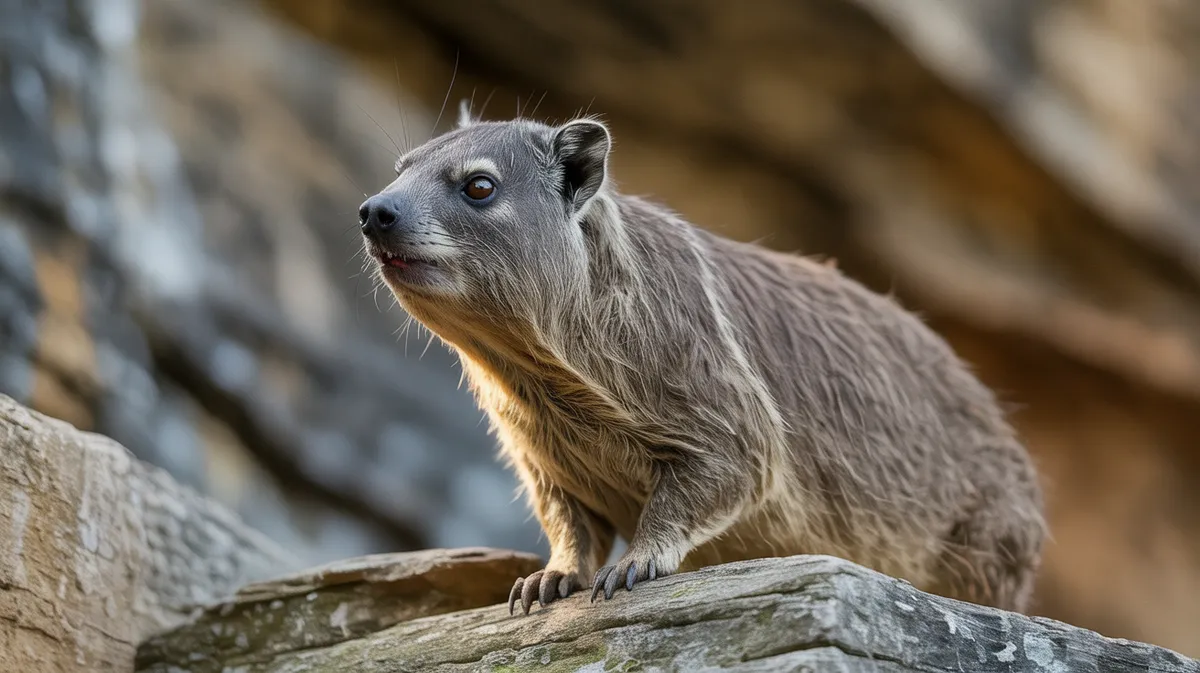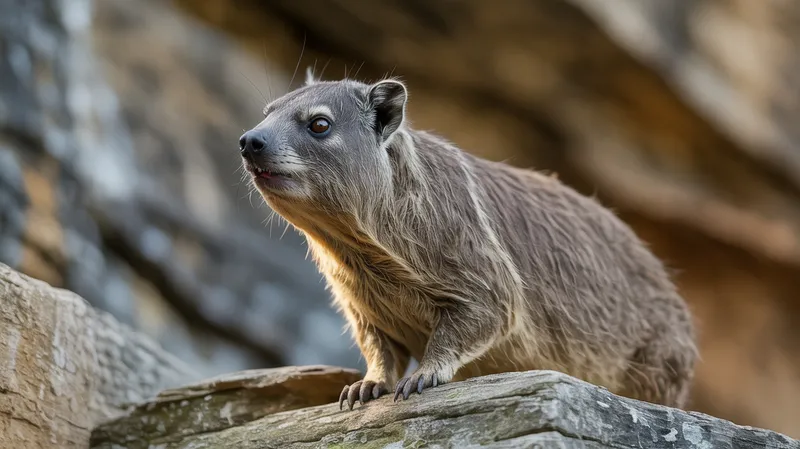
Rock Hyrax
Procavia capensis

Meet the Rock Hyrax
The rock hyrax is a small, thickset herbivorous mammal native to Africa and the Middle East. Despite its rodent-like appearance, it is more closely related to elephants and manatees than to rodents. Rock hyraxes have short fur, rounded ears, and a stumpy tail, and they are known for their agile climbing abilities on rocky terrain. They live in colonies for protection, using vocalizations and scent markings to communicate. Hyraxes regulate their body temperature by basking in the sun and seeking shade or crevices during extreme temperatures.
Classification
Mammal
Habitat
Rocky outcrops and cliffs
Diet
Herbivore
Lifespan
9-14 years
Conservation
Least Concern
Weight
1.8–5.4 kg
📖Fascinating Facts
Excellent Climbers
Rock hyraxes are remarkable climbers, thanks to their moist, rubbery footpads and strong legs, allowing them to scale steep cliffs and rocky terrain with ease.
Vocal Communicators
They use a variety of vocalizations, including whistles, grunts, and trills, to communicate with each other, especially to warn of predators.
Surprising Relatives
Although they look like rodents, rock hyraxes are more closely related to elephants and manatees, sharing a distant common ancestor.
📋Detailed Description
The rock hyrax (Procavia capensis) is a robust, medium-sized mammal measuring 40–60 cm in length and weighing between 4 and 5 kg, with females typically being slightly larger than males. Its dense, brownish-grey fur provides camouflage among rocks and some insulation against temperature extremes. The body is compact with a short, almost invisible tail, and the head is rounded with prominent, forward-facing eyes adapted for keen vision. Rock hyraxes have rubbery, glandular pads on their feet, equipped with sweat glands, which enhance grip and allow them to climb steep, rocky surfaces with agility. Their incisors are ever-growing and tusk-like, reflecting their evolutionary relationship to elephants. Colonies can range from a few individuals to over 50, living in complex social groups with dominant males, subordinate males, females, and juveniles. Vocalizations are highly developed, including alarm calls, territorial songs, and contact calls, facilitating intricate social communication. They are diurnal, spending mornings basking in the sun to raise their body temperature and foraging during the cooler parts of the day. Rock hyraxes are primarily herbivorous, feeding on a wide variety of leaves, grasses, fruits, and bark, and have a multi-chambered stomach for efficient fermentation and digestion of fibrous plant material.
💡 Did you know?
Rock hyraxes have an unusual thermoregulation system and do not maintain a constant body temperature throughout the day.
🔬Research & Sources
Wikipedia Summary
The rock hyrax, also called dassie, Cape hyrax, rock rabbit, and coney, is a medium-sized terrestrial mammal native to Africa and the Middle East. Commonly referred to in South Africa as the dassie, it is one of the five living species of the order Hyracoidea, and the only one in the genus Procavia. Rock hyraxes weigh 4–5 kg (8.8–11.0 lb) and have short ears.
Last Modified: 5/23/2025
🎭Behavior & Social Structure
Rock hyraxes exhibit a highly social lifestyle, forming colonies that provide protection against predators such as eagles, leopards, and snakes. They maintain a strict social hierarchy, with dominant males defending territories and access to breeding females. Group members engage in cooperative behaviors such as communal basking and sentry duty, where individuals take turns watching for danger and sounding alarm calls. Feeding is typically a group activity, and hyraxes may travel short distances from their shelter to forage. They are known for their complex vocal repertoire, including distinct calls for different types of predators and social contexts. Daily routines are influenced by ambient temperature: hyraxes bask in the early morning and late afternoon, while seeking shade or shelter during midday heat. Grooming and allopreening are common, reinforcing social bonds within the colony.
👶Reproduction & Life Cycle
Rock hyraxes are polygynous, with dominant males mating with multiple females within their territory. Breeding seasons vary geographically but often coincide with the rainy season to ensure food availability for lactating females. Gestation lasts approximately 6.5–8 months (210–240 days), unusually long for a mammal of their size, resulting in well-developed young at birth. Litters typically consist of 2–3 offspring, though up to 6 have been recorded. Newborns are precocial, with open eyes and fur, and begin to eat solid food within a few days, although they nurse for up to 3 months. Both mothers and other females in the colony participate in caring for the young, a behavior known as allonursing. Sexual maturity is reached at around 16–17 months.
🛡️Adaptations & Survival
Rock hyraxes possess several notable adaptations for survival in rocky habitats. Their specialized footpads secrete moisture, creating suction that aids in climbing smooth rock surfaces. The multi-chambered stomach, similar to that of ruminants, allows for efficient breakdown of tough, fibrous plant material. Thermoregulation is achieved through behavioral means, such as sun basking and retreating into crevices to avoid temperature extremes, as they have limited physiological ability to regulate body temperature. Their keen vision and wide field of view help detect predators, while cryptic coloration provides camouflage. Social living enhances predator detection and defense, and their vocal communication system is among the most complex in small mammals.
🎨Cultural Significance
The rock hyrax holds a prominent place in local folklore and religious texts. It is mentioned in the Bible as the 'coney,' noted for its wisdom in seeking refuge among rocks. In South Africa, the animal is known as the 'dassie' and features in indigenous stories and proverbs. Traditionally, hyrax dung (hyraceum) has been used in folk medicine and as incense due to its strong, musky odor and high content of plant resins. In some areas, hyraxes are hunted for their meat and skins, though this is not widespread.
🔬Recent Research & Discoveries
Recent genetic studies have clarified the phylogenetic relationships within Hyracoidea, confirming the close evolutionary ties between hyraxes, elephants, and sirenians (manatees and dugongs). Ongoing research focuses on the complex vocalizations of rock hyraxes, revealing that their songs convey individual identity, social status, and even emotional state. Studies of their thermoregulatory behavior have provided insights into how small mammals cope with extreme environmental conditions. Additionally, research on their gut microbiome is shedding light on adaptations for digesting fibrous diets in arid environments.
🎥Wildlife Videos

An Introduction to: The Rock Hyrax
Trying out a new thing. I want to turn this into a series. The plan is to use humor mixed with information to get people around my ...
Matthew Rasero

Adorable Baby Rock Hyraxes Have Been Born | The Secret Life of the Zoo | Nature Bites
Prepare for cuteness overload with this Nature Bites video featuring the birth of adorable baby rock hyraxes! These furry creatures ...
Nature Bites

Deadly Eagles Pluck Rock Rabbits in Flight
A family of rock hyraxes goes about their lunch when they suddenly come under attack by a pair of hungry Verreaux's eagles.
Love Nature

This Furry Potato Is An Evolutionary Mystery
Hyraxes are furry potatoes that look a lot like rodents, but at the mammal family reunion, you won't find them sitting by the ...
Bizarre Beasts

The WILDlife of Filmmaking: Hyrax
We are out in the deserts of Namibia is search of an odd fuzzy animal that most people don't even know exists. This mysterious ...
Running Wild Media

Hyrax: The Tiny Giants of the Animal Kingdom!
Discover the fascinating world of hyraxes, the tiny giants of the animal kingdom! In this captivating video, we delve into the unique ...
Wildlife Chronicles with Luis Garza
🌍Habitat Information
The Rock Hyrax typically inhabits Rocky outcrops and cliffs environments. Rock Hyraxs have adapted to their environments with specialized features and behaviors.
Primary Habitat:
Rocky outcrops and cliffs
More detailed habitat information will be available soon.
🛡️Conservation Status
The Rock Hyrax is currently classified as Least Concern. Conservation efforts are crucial for preserving this species for future generations.
Common Threats:
- 🏠Habitat loss and fragmentation
- 🌡️Climate change impacts
- 🎯Hunting and poaching
- 🏭Human-wildlife conflict
⚠️Threats & Conservation Challenges
Currently classified as Least Concern by the IUCN, rock hyrax populations are generally stable across their wide range. However, local declines can occur due to habitat destruction, hunting for meat and skins, and competition with livestock for food resources. In some regions, they are considered agricultural pests due to crop raiding. Predation by birds of prey, carnivores, and snakes remains a natural threat. Climate change and habitat fragmentation may pose future challenges by altering the availability of suitable rocky habitats and food sources.
🔬Scientific Classification
Scientific Name
Procavia capensis
Classification Hierarchy
🔍 About Taxonomic Classification
Taxonomic classification is a hierarchical system used by scientists to classify and organize living organisms based on shared characteristics and evolutionary relationships.
The system moves from broad categories (Kingdom) to increasingly specific ones, with each animal's scientific name typically consisting of its Genus and species.
📝Community Notes
Share your observations and insights about the Rock Hyrax with our community of wildlife enthusiasts.
Join Our Community
Sign in to share your observations and connect with fellow wildlife enthusiasts.
Sign In to ContributeNo community notes yet
Be the first to share your observations about the Rock Hyrax!
Explore Rock Hyrax
Select a tab above to learn more about this amazing animal.
📸Photo Gallery
No photos available for this animal yet.
🌟Discover More Wildlife
Continue your journey of discovery with more fascinating animals from our database
